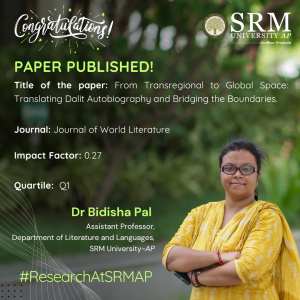- The Anxiety of Indianness in the Making of Sindhi Literature January 28, 2025

Very often, it is assumed that the “vernacular” language texts in India do not undergo any anxiety of proving themselves Indian while works written in English do. In her research paper, “A Literature of Frustration and Failure”: The Anxiety of Indianness in the Making of Sindhi Literature as an Indian Literature”, published in the esteemed Q2 journal Journal of Sindhi Studies, Dr Soni Wadhwa, Assistant Professor, Department of Literature and Languages, focuses on Sindhi post literary activity that unfolded in the first 20 years after independence to show that Sindhi has a history of going through anxiety of belonging in India.
Abstract
Studies of Partition frequently turn to literature to understand how displacement processes, among other things, impact aesthetics and representation. The article takes a broader view of aesthetics as representation: it demonstrates how turning to the literary archive of a moment and a community gives rise to questions about the politics of individual texts and literary historiography. Centred on Sindhi literature produced in India after Partition, it shows that examining the literary productivity of the community needs to involve questions of literature as political survival. It focuses on the earliest essays from the Sindhi literary scene in India (published in the Sahitya Akademi journal Indian Literature). The article argues that these essays register anxiety about the survival of a language trying to come into being in an already existing and complicated language-nation relationship. It unpacks three registers of anxiety visible in the literary archive to broaden the scope of the conversations around the Sindhi language and its literature.
This research has been conducted to advance interest in and conversations around Sindhi literature in India. Since Sindhi does not have a state in India, most people are not aware that it exists as a language and that it has a rich literary tradition.
After this article, Dr Soni Wadhwa intends to explore different writers, themes, and movements in Sindhi literature.
Collaborations
The research has been funded by George Mason University.
Continue reading → - Dr Bidisha on Translating Dalit Voices December 25, 2024
 Translation often serves as a vital bridge between languages and cultures and Translators are often poised as “gatekeepers” who preserve the authenticity and richness of a text. Dr Bidisha Pal, Assistant Professor at the Department of Literature and Languages in her research paper, “From Transregional to Global Space: Translating Dalit Autobiography and Bridging the Boundaries” speaks of the power of translation in safeguarding and raising awareness of caste. Her work also illustrates how translation smoothens the divide between language and enables the voice of the marginalised to be heard.
Translation often serves as a vital bridge between languages and cultures and Translators are often poised as “gatekeepers” who preserve the authenticity and richness of a text. Dr Bidisha Pal, Assistant Professor at the Department of Literature and Languages in her research paper, “From Transregional to Global Space: Translating Dalit Autobiography and Bridging the Boundaries” speaks of the power of translation in safeguarding and raising awareness of caste. Her work also illustrates how translation smoothens the divide between language and enables the voice of the marginalised to be heard.Abstract:
The present research brings forward some standpoints. First, the translation of Dalit autobiographies creates transnational solidarity. Second, the translators play the role of gatekeepers to show that translation sustains the literary and cultural essence ingrained within the texts and initiates and engages dialogic discussions among the audience and readers on the global platform. Third, the translation of Dalit autobiographies arrests the attention of those global readers who barely nurture any idea on caste, class, and casteist politics and deep-rooted issues like untouchability in India and constructs a distinct literary geography.
Explanation in layperson’s terms:
The research deals with the idea of literary translation and its necessity. These two autobiographies are written in regional Bengal. When translated, the boundary of regions gets dissolved, and the essence of the texts reach the global arena. Besides, translation also acts as the bridge to the outer world. However, oftentimes the act of translation is not an innocent act anymore; rather it interferes with the original meaning to transcreate.
Practical/ Social Implications:
The research talks about translation and its necessity to bridge boundaries. The texts that the article focuses on are from the people of the marginalized communities of Bengal who write to voice their concerns and who feature in a considerable period of history that should be known to people. Since, linguistic regionalism is the main constraint for the literary texts, translation provides the desired space and opportunity to help them reach the global platforms and their history and literature become part of the larger repertoire of World Literature.
The link to the article:
Journal of World Literature Volume 9 Issue 4 (2024)
Continue reading →




